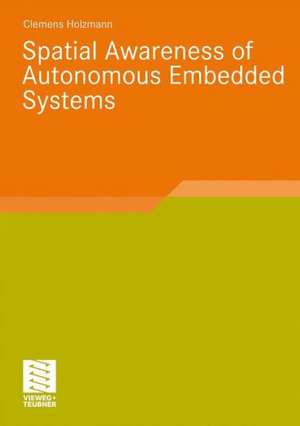Spatial Awareness of Autonomous Embedded Systems
Autor Clemens Holzmannen Limba Engleză Paperback – 25 mar 2009
Preț: 691.79 lei
Preț vechi: 864.74 lei
-20% Nou
Puncte Express: 1038
Preț estimativ în valută:
132.39€ • 137.43$ • 110.39£
132.39€ • 137.43$ • 110.39£
Carte tipărită la comandă
Livrare economică 22 martie-05 aprilie
Preluare comenzi: 021 569.72.76
Specificații
ISBN-13: 9783834807984
ISBN-10: 3834807982
Pagini: 230
Ilustrații: XXII, 206 p. 48 illus.
Dimensiuni: 148 x 210 x 14 mm
Greutate: 0.28 kg
Ediția:2009
Editura: Vieweg+Teubner Verlag
Colecția Vieweg+Teubner Verlag
Locul publicării:Wiesbaden, Germany
ISBN-10: 3834807982
Pagini: 230
Ilustrații: XXII, 206 p. 48 illus.
Dimensiuni: 148 x 210 x 14 mm
Greutate: 0.28 kg
Ediția:2009
Editura: Vieweg+Teubner Verlag
Colecția Vieweg+Teubner Verlag
Locul publicării:Wiesbaden, Germany
Public țintă
ResearchCuprins
Spatial Awareness.- Representation of Space.- Distributed Spatial Reasoning.- Rule-Based Spatial Awareness.- Zones-of-Influence Framework.- Framework Evaluation.
Notă biografică
Dr. Clemens Holzmann is a research and teaching assistant at the Institute for Pervasive Computing of the Johannes Kepler University of Linz (Austria). His research interests include location awareness and context awareness as well as wireless ad hoc and sensor networks.
Textul de pe ultima copertă
Our environment is increasingly pervaded by embedded systems which are integrated into everyday objects, equipped with sensors and actuators, networked among each other and available at any time and in any location. These computationally augmented real-world objects must be supplied with context-awareness and need to share the perceived context-information to enable them to operate more autonomously.
Clemens Holzmann investigates the role of spatial contexts for autonomous embedded systems, in particular the position, direction, and spatial extension of objects with respect to an external reference system or other objects. The author presents concepts for recognizing, representing, and reasoning about qualitative spatial relations and their changes over time, as well as an appropriate architecture which has prototypically been implemented in a flexible software framework. His results show that the proposed concepts are suitable for developing spatially aware applications and that qualitatively abstracted relations can constitute an adequate basis for this purpose.
Clemens Holzmann investigates the role of spatial contexts for autonomous embedded systems, in particular the position, direction, and spatial extension of objects with respect to an external reference system or other objects. The author presents concepts for recognizing, representing, and reasoning about qualitative spatial relations and their changes over time, as well as an appropriate architecture which has prototypically been implemented in a flexible software framework. His results show that the proposed concepts are suitable for developing spatially aware applications and that qualitatively abstracted relations can constitute an adequate basis for this purpose.













